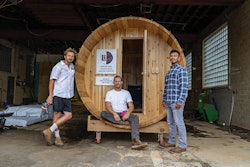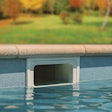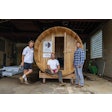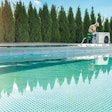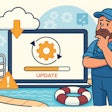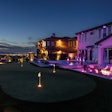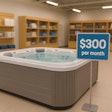
Although drowning has always been an issue pool and spa professionals must face, for far too long the subject was swept under the rug. Today, more and more industry professionals are working together to form and join organizations that aim to to reduce drownings and educate homeowners on the importance of drowning safety by providing low-cost or free safety brochures, Web sites that include links to additional safety information and programs that can be integrated into local events.
Retailers and other aquatic professionals can help these organizations spread the word by recommending that homeowners use various layers of protection around their pools and hot tubs, and provide constant and strict adult supervision. Educating homeowners about how to recognize a victim in distress as well as how to prepare for an emergency can also help to reduce the number of people drowning each year.
Following is a list of national organizations that might be helpful for dealers interested in promoting safety in and around pools and spas.
American Red Cross (ARC) 025 E Street NW • Washington, D.C. Phone: 202/303-4498 • Web site: redcross.org
MISSION: The American Red Cross provides relief to victims of disasters and helps people prevent, prepare for and respond to emergencies.
The American Red Cross is an advocate for water safety and lifeguard training, and stresses that it is essential for people everywhere to learn how to be safe in and around water. To help promote its vision, the American Red Cross has organized and maintained nearly 900 national chapters, and has developed water safety materials, including its low-cost Water Safety Handbook , which provides homeowners with general water-safety tips, information on the risk of drowning, and emergency-action plans. The organization also provides various programs through community facilities, including its new Swimming and Water Safety program, which provides information about the importance of water safety training and being safe in and around water. More than 3.7 million people enrolled in American Red Cross aquatic programs in 2004.
Association of Pool & Spa Professionals (APSP) 2111 Eisenhower Ave. • Alexandria, Va. Contact: Suzanne Barrows • Phone: 703/838-0083 Web site: theapsp.org
MISSION: The Association of Pool & Spa Professionals is an international trade association representing companies and individuals in the swimming pool, hot tub and recreational water industries. APSP members adhere to a code of ethics in business and technical practices and share a strong commitment to the safe, healthful and enjoyable use of industry products.
The Association of Pool & Spa Professionals represents aquatics professionals through various Web sites, annual awards and educational and technical seminars. APSP also says that with the help of its members, it is able to fund an extensive public service campaign that educates people on safe behavior in recreational water settings. The yearly campaign reaches more than 32 million households.
U.S. Consumer Product Safety Commission (CPSC) 4330 East-West Highway • Bethesda, Md. Phone: 800/638-2772 • Web site: cpsc.gov
MISSION: CPSC is an independent federal regulatory agency. CPSC works to save lives and keep families safe by reducing the risk of injuries and deaths associated with consumer products.
The CPSC says it is working to reduce the number of children 5 years of age and younger that drown in residential swimming pools. To help achieve this goal, the CPSC recently held public hearings in Tampa, Fla., and Phoenix to explore strategies on preventing these deaths. Additionally, CPSC conducts nationwide education campaigns to promote pool safety, and this year is focusing its efforts on entrapment hazards in pools and spas. CPSC says it recommends pool and spa owners consider installing a safety vacuum-release system to prevent entrapment. The organization also recently updated its Guidelines for Entrapment Hazards: Making Pools and Spas Safer , which provides information for pool owners and aquatics professionals about how to reduce entrapment dangers.
Previously, the CPSC has conducted studies on the effectiveness of pool alarms. During 1999 and early 2000, it evaluated four water disturbance alarms and a wristband, two of which used surface wave detection circuitry, while the other two detected subsurface disturbances. The wristband is supposed to alarm when exposed to water.
The CPSC says its test results showed that the subsurface pool alarms were more consistent in alarming and less likely to false alarm than the surface alarms. One surface alarm performed almost as well as the subsurface alarms, and the wristband alarmed when submerged in pool water. Because of this research, CPSC recommends homeowners who choose to use pool alarms use those that meet ASTM standards.
But because no alarm is foolproof, the CPSP also recommends homeowners use layers of protection to protect children from drowning, including close supervision, barriers around bodies of water and specific plans in the event of an emergency situation.
Free publications, including Safety Barrier Guidelines for Pools and How to Plan for the Unexpected , are available at cpsc.gov. In addition, a new swimming pool safety alert link is available, which provides additional and up-to-date swimming pool and entrapment information.
Independent Pool and Spa Service Association (IPSSA) P.O. Box 15828 • Long Beach, Calif. Contact: John Silcox • Phone: 858/467-0507 e-mail: [email protected] • Web site: ipssa.com
MISSION: The Independent Pool and Spa Service Association exists for the mutual professional benefit and growth of its members and for the continued improvement of the pool and spa industry's image.
Although IPSSA believes there are more safety discussions taking place today among professionals in the pool and spa industry, it says there is still a "bury your head in the sand" mentality among some. To combat this problem, IPSSA provides retailers, service professionals and homeowners with safety materials that are easy to read and understand, such as free safety brochures and pool safety checklists. The organization also distributes "water watch" tags free of charge to IPSSA members, provides "Close The Pool Gate. Save A Child's Life," bumper stickers to its members and has recently formed a Water Safety Committee with a purpose of establishing a drowning prevention and water safety program for IPSSA.
IPSSA says its vision for the future is to see all service companies, builders, manufacturers and retailers promote safety.
International Aquatic Foundation P.O. Box 4038, Alexandria, VA 22303 Phone: 703/838-0083 • Fax: 703-549-0493 Web site: www.iafh2o.org
MISSION: To make recreational water environments healthy, safe and enjoyable, and to advance safe use and best practices in the design and construction of aquatic facilities, including pools, spas and recreational water parks, through science, standards and education for aquatic professionals, consumers and government officials.
IAF is a nonprofit international organization with an objective to educate aquatic professionals, public health officials, consumers and academia in making recreational water environments healthy and safe. Maureen Williams, a board member and executive director of the National Drowning Prevention Alliance, says the IAF will collaborate with industry organizations to promote educational programs and materials, advance technical education and increase consumer safety awareness.
IAF also strives to develop industry standards, to provide a forum to address industry issues and to foster scientifically sound technical information. The organization's programs and services include guidelines for the design, construction and operation of aquatic industry facilities; research; educational programs for public health officials and aquatic professionals; and public safety awareness and educational campaigns.
The IAF says each year it will measure the effectiveness of its programs by tracking the number of drownings, near drowning and major injuries, such as spinal cord injuries, that occur.
National Drowning Prevention Alliance (NDPA) Contact: Maureen Williams • Phone: 800/716-0888, ext. 192 e-mail: [email protected] Web site: drowningpreventioninfo.com
MISSION: The National Drowning Prevention Alliance was formed in 2004 to maximize efforts to prevent drowning through the development and implementation of strategies to facilitate and improve education, public awareness, effective barrier codes and greater utilization of layers of protection.
NDPA comprises individuals, organizations, government agencies, policymakers and corporations, focuses on educating consumers about the importance of layers of protection around pools and eye-to-eye contact as the only effective supervision when children are in swimming pools. In addition, the organization hosts an annual National Drowning Prevention Symposium to teach health educators, pool industry representatives, homeowners, legislators and the media about up-to-date programs, strategies and products designed to help prevent drowning. The organization also provides consumers and pool professionals with pool safety information and links to additional pool-safety-related Web sites at drowningpreventioninfo.com.
National Swimming Pool Foundation (NSPF) 224 East Cheyenne Mountain Blvd. • Colorado Springs, Colo. Contact: Margaret Smith • Phone: 719/540-9119 e-mail: [email protected] • Web site: nspf.org
MISSION: The National Swimming Pool Foundation is a nonprofit organization encouraging healthier living through aquatic education and research.
The National Swimming Pool Foundation says its vision of aquatic safety involves freedom from aquatic danger, risk and injury by reducing drowning, recreational water illness, diving injuries and suction entrapment injuries.
For decades, NSPF has funded research to help understand and prevent suction entrapment and diving injuries. In 2005, the foundation budgeted $500,000 for research grants and fellowships that will aid in preventing recreational water diseases and injuries, and will help to identify, understand and communicate health benefits of water. The research will be presented at the World Aquatic Health Conference, Sept. 19-21, 2005, and in scientific journals. The foundation says this research will help guide public policy and new product development to serve homeowners. In addition, NSPF has published educational materials, including the Aquatic Safety Compendium CD, which provides scientific information about catastrophic injuries that are related to swimming pools and hot tubs. The NSPF Web site also contains various articles and brochures that provide safety information to dealers and homeowners.
Pool Safety Alliance P.O. Box 2421 • Seal Beach, Calif. Contact: Corinne Zemla • Phone: 949/872-9064 e-mail: [email protected] • Web site: poolsafetyalliance.com
MISSION: The Pool Safety Alliance aims to improve swimming pool safety by bringing together, on a national basis, pool designers and builders, children's health providers and safety advocates, manufacturers and related agencies or professionals in a focused, education-based effort.
This nonprofit organization, whose members include the Children's Hospital of Orange County and the Genesis 3 Design Group, says it strives to educate builders on how to address safety without fear of discouraging sales. To promote this goal, Pool Safety Alliance supplies a brochure called Beauty of Safety and offers support to groups, dealers and services who request information. Its Web site also includes information and price ranges on several pieces of safety equipment, such as isolation and mesh fencing, alarms, safety covers and nets. Visitors can also link to additional safety Web sites.



























